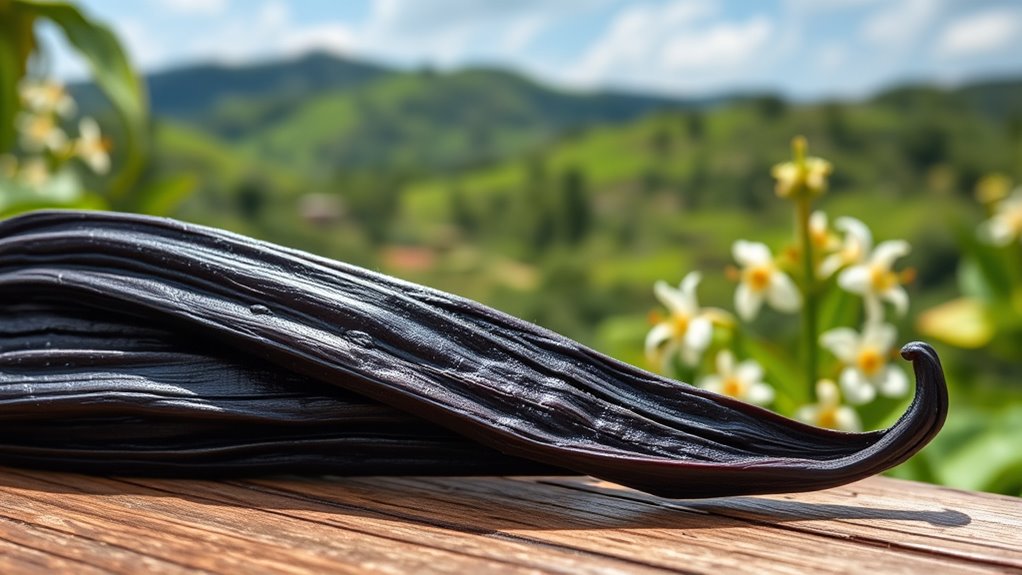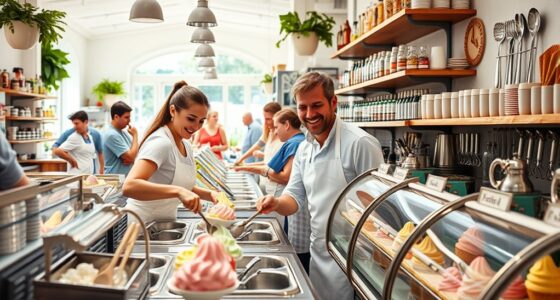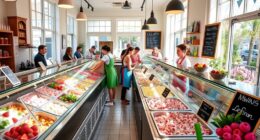When you follow a single vanilla bean from Madagascar to your scoop, you see a journey rooted in traditional farming practices and sustainable methods. Skilled farmers nurture the beans in a lush tropical climate, ensuring quality and flavor. The beans are ethically harvested, processed, and traded fairly to support local communities. This commitment to responsible sourcing guarantees a rich, authentic vanilla experience. Keep exploring to discover how these practices make your vanilla truly special.
Key Takeaways
- Trace the vanilla bean’s journey from Madagascar’s sustainable farms through ethical sourcing practices.
- Ensure fair trade certification verifies fair wages and environmentally friendly cultivation methods.
- Follow the harvesting, curing, and processing steps that preserve flavor and quality of the vanilla bean.
- Confirm transparent supply chains that guarantee the bean’s origin and adherence to ethical standards.
- Recognize how supporting fair trade vanilla benefits local communities and promotes sustainable farming.

If you’re looking to source high-quality vanilla, Madagascar should be at the top of your list. The island is renowned for its rich vanilla cultivation, producing some of the most aromatic and flavorful vanilla beans in the world. But quality isn’t the only factor to consider. Making sure that your vanilla comes from sustainable and ethical sources is equally important, and this is where fair trade practices come into play. When you choose vanilla cultivated under fair trade standards, you’re supporting farmers and communities that prioritize sustainable farming methods, fair wages, and social development. This commitment not only guarantees a higher standard of living for those involved but also makes certain that the vanilla you purchase is grown with care for the environment and workers’ rights.
Madagascar’s unique climate and soil conditions create ideal circumstances for vanilla cultivation. The plants thrive in the humid, tropical environment, and skilled local farmers have perfected their methods over generations. As you trace your vanilla back to its origins, you’ll recognize the importance of these traditional practices, which often include sustainable farming techniques that minimize environmental impact. Many farmers on the island are now adopting fair trade practices, which ensure they receive a fair price for their harvests, empowering them to invest in better equipment, health, and education for their families. Supporting fair trade vanilla helps promote social and economic development, especially in remote communities where opportunities can be limited.
When sourcing vanilla from Madagascar, it’s vital to verify that your supplier adheres to fair trade principles. This means they prioritize transparency, pay fair wages, and promote environmentally friendly practices. By doing so, they contribute to a more equitable supply chain, reducing exploitation and ensuring the longevity of vanilla cultivation on the island. This transparency also helps you, as a buyer, make informed decisions. You can confidently purchase vanilla knowing it’s not just of superior quality but also ethically sourced.
Choosing Madagascar vanilla cultivated under fair trade practices also encourages ongoing improvements in farming techniques. Farmers are motivated to maintain high standards, knowing that their efforts are recognized and rewarded ethically. This leads to better vanilla beans, more consistent quality, and a positive impact on local communities. Additionally, investing in sustainable cultivation methods can help preserve the unique soil conditions that make Madagascar vanilla so exceptional. When you finally get that vanilla bean or extract into your hands, you’re not just enjoying its rich aroma—you’re supporting a sustainable, ethical system that benefits farmers, the environment, and your palate alike. In essence, sourcing Madagascar vanilla with a focus on fair trade practices allows you to indulge responsibly while celebrating the island’s remarkable contribution to the world of flavor.
Frequently Asked Questions
How Is Vanilla Bean Quality Assessed During Sourcing?
When evaluating vanilla bean quality during sourcing, you focus on vanilla bean grading and flavor analysis. You inspect the beans’ appearance, checking for moisture, color, and plumpness. You also perform flavor analysis by smelling and sometimes tasting the beans to ensure rich, authentic vanilla aroma. High-grade beans are usually oily, plump, and have a strong, sweet fragrance, indicating top quality for your desired flavor profile.
What Environmental Factors Affect Vanilla Bean Flavor Profiles?
Did you know that vanilla beans’ flavor profiles are heavily influenced by their environment? You can see this in how pollination techniques, whether hand-pollinated or natural, affect bean quality. Soil composition also plays a role, with rich, well-drained soils enhancing flavor development. These environmental factors shape the unique aroma and taste you enjoy, making each vanilla bean’s profile distinct based on its growing conditions.
How Do Farmers Ensure Sustainable Vanilla Cultivation?
You can guarantee sustainable vanilla cultivation by supporting farmers who pursue organic certification and fair trade practices. These certifications promote environmentally friendly farming methods, reduce chemical use, and ensure fair wages. By choosing vanilla with these labels, you help encourage responsible farming, conserve biodiversity, and improve farmers’ livelihoods. Your choices directly influence sustainable practices, making sure vanilla cultivation benefits both the environment and the communities involved.
What Are the Main Challenges in Vanilla Transportation?
You face logistics hurdles when transporting vanilla, especially due to its delicate nature and remote origins. Ensuring proper storage solutions is essential to prevent spoilage from humidity, temperature swings, and delays. These challenges can cause quality loss and increase costs. To overcome them, you need efficient transportation planning, climate-controlled containers, and reliable distribution networks, keeping vanilla fresh and preserving its premium flavor from farm to your scoop.
How Does Climate Change Impact Vanilla Production?
Imagine a vanilla farm facing unpredictable droughts due to climate change. You’d see farmers adopting climate adaptation strategies to boost crop resilience, such as diversifying crops or improving irrigation. Climate change directly impacts vanilla production by altering growing conditions, risking yields and quality. To sustain supply, farmers must focus on enhancing crop resilience, ensuring they can adapt to shifting weather patterns and protect vanilla’s future.
Conclusion
As you savor that next vanilla scoop, remember the journey it took to get there—each bean hiding secrets from Madagascar’s lush fields. The story isn’t over; behind every flavor lies a world of challenges, surprises, and unseen hands. Will the next bean tell a different tale? The path from Madagascar to your cone is woven with mystery, waiting to unfold with every taste. Your experience is just the beginning of a deeper story.









